#Vintage Wooden Sewing Tools
Explore tagged Tumblr posts
Text
When it comes to sewing, the vintage wooden sewing tools you use can make all the difference. Such particularly those made of wood, offer several benefits. Visit us for more benefits of sewing tools.
0 notes
Text
For the sewing enthusiasts out there I have a question: your sewing box recs?
I have one I like ok but it cracked and I want to replace it for something a little more convenient maybe and something I actually like the look of
I have a vintage plastic serious business one that has 2 levels for little bits and things and a large space at the bottom for various threads , it fits everything but I don't like how inconvenient it is to get to the thread since I need to take out 2 trays before I can get to it
It would be easy enough to get some tubs for the thread but what to store all the other odd bits like sewing feet is stumping me, I don't want to just get a plain tool box but I am not finding a sewing box I like the look of either(they are expensive for something I don't love the look of) and a lot of them have a cheap feeling vacuum shaped plastic trays i rather hate!
I found this nail polish box (other colours on a different listing but it's listed with other styles and i don't want to confuse anyone) that I like because it has a drawer at the bottom so it would solve the tray problem with the thread but it is pretty big and pricey (the size is however comparable to my current box)
I have tried that wooden singer spreading out trays style box as well but I found it rather cumbersome
So anyways, any thoughts or ideas?
32 notes
·
View notes
Text
Launching Petal and Pine Thrift: Our Business Operations Plan
As Petal and Pine Thrift prepares to enter the online market, our operations plan is pivotal to ensuring a smooth launch and sustained success. Here’s a breakdown of how we plan to source our products, manage our operations, and bring our vision to life.
Product Sourcing:
Local ReStores and Auctions: We will source high-quality, antique wooden items from local ReStores and auctions. These venues are treasure troves for unique, vintage furniture and decor pieces that can be restored and upcycled. By purchasing locally, we support the community and reduce our carbon footprint.
Chain Thrift Stores: Chain thrift stores are another valuable resource for finding both clothing and small decorative items. We will regularly visit these stores to find hidden gems that can be revamped and sold through our online platform.
Community Donations: We will actively reach out to our local community in Haldimand Norfolk, encouraging donations of gently used clothing and antique items. By fostering a sense of community involvement, we not only gain a steady supply of products but also engage our customers in the sustainability journey.
Roles and Responsibilities:
Gennasys Smart: Will be responsible for curating and upcycling the clothing items. She will also manage our social media presence, ensuring our message of sustainability and community support reaches a wide audience.
Spencer Martin: Will focus on restoring and refurbishing antique wooden items. He will also handle logistics, including managing inventory and coordinating local package drop-offs.
Licenses and Permits: While operating an online thrift store typically requires fewer permits than a physical store, we still need to ensure compliance with local business regulations. We will register our business with the Ontario Business Registry to obtain a MBL.
Timeline and Tools for Launch:
Sourcing and Inventory Management: Over the next six weeks, we will intensify our efforts to build inventory. We aim to secure a minimum of 5 large wooden items, 10 smaller decor pieces, and 10 pieces of upcycled clothing each month. Tools needed include:
High-quality cleaning and restoration supplies for furniture.
Sewing machines and upcycling tools for clothing.
Storage solutions to organize and manage our inventory efficiently.
Marketing and Sales Platform: We will finalize our website, ensuring it’s user-friendly and showcases our products effectively. Additionally, we’ll:
Set up accounts on Instagram and Facebook to promote our offerings and engage with potential customers.
Utilize platforms like Shopify to manage sales and track inventory.
Community Engagement:
Launching a local marketing campaign to encourage donations and promote our mission. This will include:
Hosting small community events or workshops on sustainability and upcycling.
Partnering with local organizations to spread the word about our store.
Vision and Final Steps:
Our vision is to establish Petal and Pine Thrift as a cornerstone of sustainable fashion and home decor in Haldimand Norfolk. We aim to:
Provide high-quality, stylish, and affordable products.
Foster a strong sense of community and environmental responsibility.
Expand our reach while maintaining our commitment to sustainability.
With these plans in place, we are confident that Petal and Pine Thrift will not only meet its launch goals but also thrive as a beloved, eco-friendly business in our community.
0 notes
Link
Check out this listing I just added to my Poshmark closet: Vintage SEWING AND DARNING WOOD TOOL 4.5” x 2.5” - Toes and Heels MENDING ASSIST.
0 notes
Text
The Ultimate Guide: Crafting Stunning Modular Outdoor Sofas with Hidden Storage

Tired of lacking sufficient seating and organization in your outdoor living space? We'll walk through how to solve both problems in style by building your modular sofa with storage.
With a few basic carpentry skills and our detailed directions, you can fashion beautiful multi-purpose furniture perfect for relaxation and entertaining.
Key Benefits of Outdoor Sectionals with Storage
Seating and Organizer 2-in-1 - Maximize patio functionality without clutter
Convenient Access - Keep essentials handy but out of sight
Customizable Comfort - Design to your exact style, size, and storage needs
Cost Effective - Use affordable materials like crates and foam
Extend Patio Season - Cushions add comfort for cooler weather lounging
Below we outline everything needed to craft amazing sectional sofas tailored to your space from frame construction to cushions and storage setup.
Let's get started building your dream patio furniture!
Planning Your Sectional Sofa
First, decide on the shape and dimensions. Standard wooden crates are approx 22” D x 16” H. For ample seating allow 60”-80” in length.
Compact L-shapes and expansive U-shapes both maximize storage capacity underneath. Sketch layout options:
Gather the building materials:
6-12+ Wooden crates
Exterior wood screws, corner brackets
Weatherproof wood glue & filler
Primed boards (optional for sides or back enclosure)
Outdoor foam - size to crates x desired cushion thickness
Weather-resistant fabric - allow 6” extra per cushion
Throw pillows, decorative touches
Constructing the Sectional Frame
Arrange crates tightly in your planned layout. Fuse crates by screwing sturdy corner brackets into the inside edges.
Check for light leaks and fill gaps with exterior wood filler putty.
Sand and smooth all surfaces then apply weatherproof primer. Now paint or stain your customized frame to match your style.
Distress or add wood burn accents for a vintage flair.
Position assembled crates into the final sofa configuration once completely dry. Anchor the entire structure firmly to your patio surface for added stability.

Crafting Plush Modular Cushions
Precision measure crate dimensions to size your foam pieces. For a deep-seated feel, choose a thickness of 1-2 inches greater than crate depth.
Bevel foam sides and corners to contour crates in an even overhang.
On each cushion, cut weather-resistant fabric allowing approx. 6 excess inches on all sides. Sew together pieces with a zipper or Velcro closure along one side.
Insert foam then hand stitch the opening closed.
Smoothly position snug cushions onto crates. Use fabric glue strips underneath if needed to keep cushions from shifting.
Scatter colorful throw pillows for extra comfort and style!
Loading Up Integrated Storage Space
The best part of building modular sofas with storage? All that hidden capacity to organize outdoor living essentials!
Inside the hollow crates, arrange weatherproof storage bins of your choice. Neatly organized by category - patio accessories, pet supplies, kids toys, folding furniture, gardening tools...anything you need for quick access to the outdoors.
Throwing patio parties? Use crates to inconspicuously store serving supplies like extra dinnerware, glassware, and utensils within arm's reach.
Add a waterproof liner if storing ice and chilled drinks.
Finally, fluff cushions and revel in your multi-functional sofa! Thoughtfully designed to store what you need and provide cozy seating for relaxation or entertaining.
Here's to enjoying your organized, beautiful backyard oasis!
#best modular sofas canada#modular sofa canada#rezy sofa review#designer sofa toronto#best sectional sofa
1 note
·
View note
Text
9 DIY Headboard Ideas for Your Bedroom
There are some more poignant decor choices you can easily make in a bedroom than a statement headboard. It can work as the room’s focal point, tying together the color scheme and a fully realized aesthetic. A true headboard can be hard to originate, so deal with tacking a homemade version during your free weekend.
Many of the ideas are simple and quick, but they also allow you to customize the best headboard for your specific space and bed. Glance through these how-toss for a bedroom makeover inspiration, and remember to complete your decorating with a homemade throw pillow.
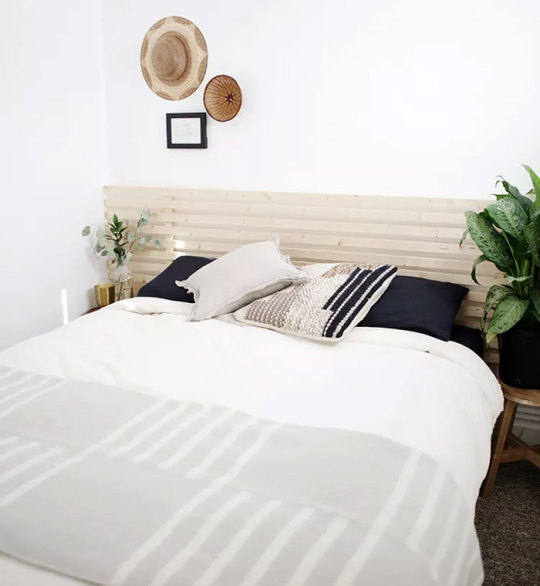
Wood Slat Headband
Transform some cheap lumber lengths into a statement-making, wall-length headboard. An oversized version is an amazing way to makeover a room. Also, it’s rental-friendly since no paint or wallpaper is needed. Try a dark stain on your lumber for a cozier vibe.
Arched Headband
A geometric, vintage-inspired homemade headboard adds comfort and warmth to your sleep space. Need more confidence with your power tool skills? Then research your options thoroughly before buying tools. After that, finish the piece using a medium wood stain.
Herringbone Headband
If your reflooring project left you with some more wooden planks, consider inserting them to use in a pretty herringbone headboard. This version gets rustic-chic, but the finished pattern is pretty enough to leave unpainted.
Light up headboard
Assimilate a conversation-starting piece in your guest room with a DIYed light-up headboard. This DIY project requires some power tools and a little patience, so enlist the help of a partner and set aside a few days to get it done but the results are worth the effort and time.
Floral Mural Headband
For those who are more artistic than builders, try a giant mural in place of a DIY headboard. An overblown, splendidly-colored flower lends a retro-tropical vibe to a kitschy bedroom. If you are not allowed to paint a rented apartment wall, then try peel-and-stick brief wallpaper trimmed to your design specifications instead.
Painted Stripe Headband
Go full-on preppy with an upcycled, painted stripe headboard. Use any flat surface like an old tabletop, desk, or extra lumber in need of a re-surface, place paint tape in long stripes, and give it a heavy coat of color. This headboard looks chic with contrasting floral bedding.
Tufted Headband
This elegant or eye-catching velvet tufted headboard works as a centerpiece in a maximalist bedroom. While this DIY project may seem intimidating, it’s truly completely no sew and accessible for novices.
Fluffy Headband
Textural contrasts are important when designing an inviting bedroom, so begin with a fuzzy headboard. Source fabric from a wholesale vendor to make this quirky headboard on a tight budget. It’s best for a tween transitioning from their bedroom to something with more personality.
Hanging Cushion Headband
Equal parts, comfortable and stylish, an up-cycled cushion headboard can easily make your bedroom cozier. While you can stitch cushion covers easily and quickly, non-sewers can easily get away with pinning a powerful fabric onto old cushions instead. This DIY headboard looks chic when paired with a minimal platform bed, so test your DIY skills by building one yourself.
Also Read: 15 Ideas for Decorative DIY Bookends
Final Verdict
A DIY headboard can add a major impact to any room decor. No matter what’s the size. In a large room, a headboard can be helpful; filling the space in a small bedroom makes the sleeping area feel more special. As for design, there are various headboard styles to choose from, and in the above section, you will find some attractive DIY headboard ideas you can create for your home.
Source:https://hariguide.com/diy-headboard-ideas-for-your-bedroom/
0 notes
Text
Vintage wooden spools hold so much magic!

#magic#vintage wooden spools#old sewing tools#spools and scissors#black and white#art is magic#magic is art
5 notes
·
View notes
Photo

Presumed ‘sewing box’ - found online - cute!
#sewing box#mending#sewing supplies#sewing#sewing tools#hand sewing#sewing supply storage#vintage sewing#vintage sewing box#victorian sewing box#wooden sewing box#primitive sewing box
27 notes
·
View notes
Note
so I've noticed that you and the tutorials you recommend for darning use an embroidery hoop. which frankly I've never heard of. I've only ever seen darning done with one of those wooden "eggs" and I'm curious as to why an embroidery hoop over the more traditional method? or is the egg only for socks?
Interesting question! Let's take a look at darning and darning tools.
Darning eggs or embroidery hoops?
What is darning:
Darning is a sewing technique used to repair holes or worn areas in fabric, using a needle and thread.
Woven fabric consists threads crisscrossing each other. These threads are called a warp and a weft: the warp threads are the vertical base of the fabric, while the weft threads are the threads that are drawn through these warp threads during the weaving process.
When we're darning woven fabrics, we first create new warp threads across our hole, then weave new weft threads through them.
(There's also Swiss darning which is a technique used on knits, but let's leave that for another day.)
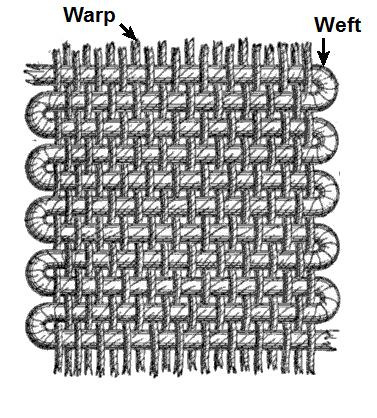
(Image source) [ID: a diagram of woven fabric, showing the vertical warp threads and horizontal weft threads.]

(Image source) [ID: Vintage instructions on how to darn a hole.]
Darning tools:
Darning is a whole lot easier when the fabric you're trying to repair is pulled taut, similar to how weaving is usually done on a loom. This helps to keep the tension on your fabric even, avoiding loose or uneven stitching.
Both darning mushrooms/eggs and embroidery hoops can be used to pull your fabric taut.
For example, if you're fixing something that's difficult to handle (e.g. small cylinders like socks or gloves), you can employ a darning egg to pull the fabric taut while darning so you don't need to put your hand inside of your garment. Situations like these won't work with a hoop because those cylindrical items are too small for most hoops.
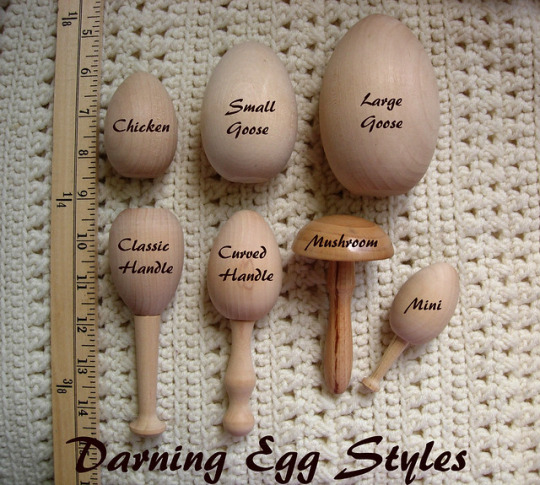
(Image source) [ID: seven different darning egg sizes and types: chicken, small goose, large goose, classic handle, curved handle, mushroom, and mini.]
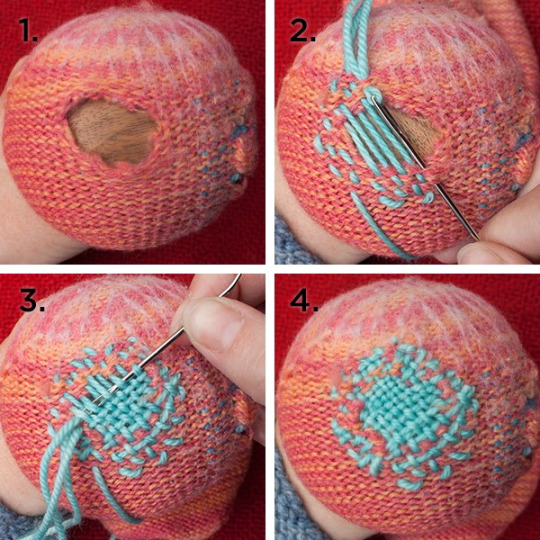
(Image source) [ID: a red sock with a hole in it in progress of being darned with blue thread over a wooden darning egg.]
If you're fixing up bigger holes, or holes in fabric of which you can easily reach the back, an embroidery hoop might be more convenient depending on your personal habits.

(Image source) [ID: a piece of denim fabric in progress of being darned with the use of an embroidery hoop and yellow, orange, and red thread.]
You could also use something else to pull your fabric over, like a jam jar, a light bulb, or a tennis ball. I personally don't own a darning egg, so I tend to use glass bottles when darning items that can't be put into an embroidery hoop.
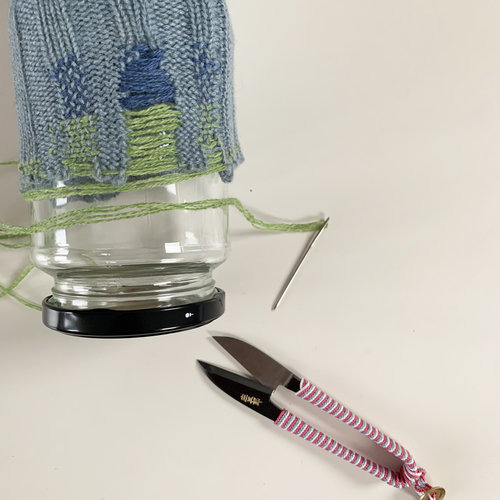
(Image source) [ID: a gray knit sleeve in progress of being darned with blue and green thread. The sleeve is pulled over an empty jam jar.]
Conclusion:
You can use both a darning egg/mushroom and an embroidery hoop to darn your clothes. Which one to choose depends on your personal preferences and the type and size of garment you're trying to mend.
EDIT: someone commented not to use light bulbs as they may shatter and hurt you, which is a good point. The ones I've got around aren't made from glass, but I didn't consider that might not be the case for all types of bulbs.
#wasteless crafts#tutorial#diy#mending#sewing#weaving#darning#visible mending#darning egg#darning mushroom#embroidery#embroidery hoop#global warming#climate change#ask#tools#crafts#fibre arts#fibre crafts#fast fashion#slow fashion#sustainable fashion#reuse reduce recycle#sustainability
5K notes
·
View notes
Text
Things I’d love to keep in my handbag / backpack to casually pull out at any suitable occasion as if it was the most normal thing in the world:
rubber gloves - to pick up broken glass or suspicious items at a crime scene (or anything that could possibly be a crime scene), anything contaminated with chemicals, a poisonous frog…
the folding magnifier I bought for botany class last semester - can be used for similar purposes as above or just to identify species
a test tube with a lid plus a zip locked bag to collect samples
my vintage compass
the Gandalf-would-use-it-looking pipe I bought at a market during a schooltrip to Poland plus some pipe tobacco just for the aesthetic
tweezers
flower seeds
a candle and matches
a little sewing kit - thread, needles, buttons, scissors
my Swiss army knife or a smol multifunction tool
a piece of wire
a spoon
teabags
a bag of soup (I don’t really know why… I just think it could be funny to hand it someone who says they’re hungry)
a small instrument - a harmonica, a recorder…
a first aid kit that seems slightly off? like it’s of perfect use but includes some weird items that look at least half a century old? - old (looking) scissors, a wooden / metal stethoscope… (if anyone has specific knowledge about historical medical instruments feel free to add!)
cloth handkerchief my grandma crocheted around
antique tin botanical box (I know that’s probably too big to fit in a bag but anyway I think that’s cool)
a tiny flask with wine
…
feel free to add more ideas!!
#chaotic time traveller academia#dark academia#light academia#dark acadamia aesthetic#light acadamia aesthetic#science academia
48 notes
·
View notes
Photo

Ariele makes furniture out of recycled parts and her workshop is right in the middle of her, and boyfriend Isaiah’s, wonderful Brooklyn, New York apt.

The mantel in their living room is always changing, much like the coffee table rotation they have going on.

Additionally, they have a great eye for recycled decor.

Ariele says, “This is also a place where I store tabletops before they get shipped out. To me, they are art first and furniture second, so I rather enjoy them propped up against a wall.”

The mountain goat head is actually not taxidermy at all, but rather something she made by carving foam and covering with vintage rabbit fur; the horns and nose are made from wax and black pigment.

She made the art out of eucalyptus leaves and the lamp from old dumbell parts.

Here’s the shop in middle of everything. It wasn’t intended to get this crazy, but she just kept building more stuff and buying more tools.

The wall in the background is an old sculpture Ariele created while still in college; it was essentially her thesis.

Love the old windows.

Ariele made the chandelier entirely of paper, namely vintage sewing patterns and the pages of her favorite book that was falling apart. The porcelain-topped table was Isaiah’s great-grandmother’s.


The island in the kitchen is one of the first things they built together when they moved in; there was no counter space before that! The metal signs on the wall, they found in the trash.

Ariele’s favorite piece of furniture in the bedroom is that old wooden flat-file. She found it on Craigslist for 40 bucks, long before she had a car, and carried it all the way home on the subway. She cut those little colored flags out of free Martha Stewart paint chip samples from Home Depot.
http://www.designsponge.com/2012/03/sneak-peek-ariele-alasko-isaiah-palmer.html
65 notes
·
View notes
Text
When it comes to sewing, the vintage wooden sewing tools you use can make all the difference. Such particularly those made of wood, offer several benefits. Visit us for more benefits of sewing tools.
0 notes
Text
Wes was born Febuary 7, 1975
-He is currently 25 year old
-Wes was born in Richmond, VA and then moved to Nashville Tennessee from age 10-15. Then he moved to Jacksonville to study art at a highschool.
-Wes was beat up almost every single day in the 9th grade.
-Wes is 6'1" Tall
-Wes is short for Wesley, Which is an English name that means the "West Meadow".
-Wes has A.D.D. for which he takes medication. According to him, that medication is (Dexedrine) which is a form of Speed that is legal.
-Wes was Baptized and made to go to Church every day of his younger life. He is not really interested in Religion,but he is looking for other truths.
-His dad is a Presbyterian Minister
-Wes's parents names are Tom and Sally. which completes the Borland familly with Tom, Sally, Wesley and scott. -Married since 4-10-98. To Heather McMillan Borland, who is beloeved to be
Wes's long time girlfriend ( but now she is he's wife).
-Completely devoted to his wife and states "totally in love with her"
-Wes's honeymoon consisted of taking his wife to theme parks across the country.
-Heather is an English name meaning flowering shrub.
-Talks to his wife for each night.
-Heather is currently going for her real estate liscense.
-His favorite color is yellow
-His favorite thing to drink is Coffee
-His favorite movie is Star wars and he loves to wath Sci-Fi
-Wes is a artist who loves to draw and is always doodling things on walls and other places. He also helped do the artwork on the CD's also. He's a really talented person.
-Wes listens to Ween, Tool, Metallica, Megadeth, David Bowi, Slayer, Primus, Tori Amos, Ministry, Bad Brains, Morbid Angel, Judas Priest, Lisa Gerard and a little bit of Sarah McLachlan.
One of Wes Borlands other hobbies is sewing which he is obviously good at because he makes his own costumes that he wears on stage. He owns two sewing machines and even a Vintage 1940's Singer sewing machine.
-He has a wooden rabit named Lucy because he has a likeness toward bunnies.
-Likes to give the crowd a show and seperate his on stage life form his home
life wearing outrageous outfits.
-Loves to collaborate with other artists
-Loves to play pranks
3 notes
·
View notes
Text
Okay, next on my “Animal Crossing Stuff I’m Looking For” list!
I’m looking for yellow pansies and yellow roses, as well as these items, in order of importance:
Wester-Style Stone Stone Lion-Dog Zen-Style Stone Stonehenge Mossy Garden Rock Katana Flat Garden Rock Tall Garden Rock Moai Statue Beach Towel Beach Ball (not the watermelon one, I have that one, I would be willing to trade it for a different beach ball) Ukulele Beach Chair Sand Castle Palm-Tree Lamp Poolside Bed Coconut Juice Surfboard Log Bench Fire Pit Firewood Log Dining Table Tiny Library Candy Machine Climbing Wall Flower Stand Garden Bench Garden Wagon Handy Water Cooler Natural Square Table Plastic Pool Popcorn Machine Street Organ Tennis Table Under the cut I have a list of fossils I have that I’m willing to trade, I have all the fruit I’m willing to trade, recipes for the Light Bamboo Rug and the Bamboo Doll, and I have a number of hybrid flowers and types that I’m willing trade. If you want, there’s also a list of my catalog and color variations below that I can order and have sent to you! Message me if you’re interested in trading!
FOSSILS
Acanthostega Ankylo Skull Ankylo Torso Myllokunmingla Megacero Torso Mammoth Skull Left Quetzal Wing Iguanodon Torso Deinony Torso Deinony Tail Right Quetzal Wing Spino Skull Stego Torso T. Rex Skull Tricera Tail Trilobite
FURNITURE CATALOG
Amp - Pink Anatomical Model Arcade Seat - Grey Autograph Cards - Signature, Handprints Automatic Washer - Green Basketball Hoop - Black Bathroom Sink - Black Bathroom Towel Rack - Silver Beach Ball - Watermelon Board Game - Territory Game Book - Western Literature, Encyclopedia Bottled Ship - Leisure Boat
Camping Cot - Yellow Candle - White Cardboard Box - Plain, Oranges, Cherries Cassette Player - White, Black Chalkboard - Art Changing Room - Green Coffee Cup - Royal Coffee Grinder Cordless Phone - Silver Corkboard - Natural Cream and Sugar - Brown Cushion Cute Bed - White Cute Floor Lamp - White, Red Cute Tea Table - White Cypress Plant - Blue Den Chair - Black, Brown Den Desk - Brown Wood Desk Mirror - Gold Diner Neon Clock - Red Diner Neon Sign - Purple Diner Sofa - Pink Dinnerware Director's Chair - Black Dolly - Red Double Sofa - Blue Drying Rack - White Elephant Slide - Red, Gray Espresso Maker - White Essay Set - In Progress Exercise Ball - Pink Exercise Bike - Yellow Fan - White, Pink Film Projector Floating-Biotope Planter - White Floor Light - White Floor Seat - Dark Wood Floor Sign - No Parking Foosball Table - Brown Football Formal Paper - Brown Fortune-Telling Set - Purple Futon Garbage Can Garbage Pail Garden Faucet - Stainless Garden Gnome - Sprightly Gnome Garden Lantern - White Gas Range - Blue Gears - Silver Globe - Standard Hammock - Brown Hamster Cage - Blue Handcart - Green Imperial Chest - Brown Imperial Decorative Shelves - Brown Inflatable Sofa - Purple Ironing Set Kimono Stand Kitty Litter Box - Green Kotatsu Lab-Experiments Set Lantern - Red Lawn Mower - Yellow Lecture-Hall Bench - Dark Brown Loom Magazine Magnetic Knife Rack - Wooden Mama Bear - Cream Metronome - Red, Cream Mic Stand Microwave - Black, Green Mini-Cactus Set Modern Office Chair - Yellow, Light Blue Monstera - Black Moss Ball Mountain Bike - Green, Blue Mounted Blue Marlin Mr. Flamingo - Natural Mrs. Flamingo - Natural Mug - Turquoise, Black Nintendo Switch - Neon Blue & Red, Gray Oil Lamp Old-Fashioned Alarm Clock - Gold Pants Press - Brown Paper Lantern - Dark Wood, Orange Wood Party Garland - Gorgeous Pendulum Clock Picnic Basket - White Portable Radio - Yellow Portable Record Player - Blue, Black Pro Tape Recorder - Gray Rattan Bed - Brown Rattan Stool - Light Brown Rattan Table Lamp - Brown Record Box - Black Revolving Spice Rack - White Rock Guitar - Orange-Yellow Rocket Lamp - Blue School Chair - Brown & White Serving Cart - Natural Sewing Machine - Green Shaded Floor Lamp - Red Shaved-Ice Maker - Green Simple Kettle - Red, Yellow Simple Panel - White Skeleton Sleeping Bag - Blue Snow Globe Stand Mixer - Black Stovetop Espresso Maker - Black Studio Spotlight - White Tankless Toilet - Pink Tapestry - Geometric Pattern Tea Set - White Telescope Throwback Wall Clock - Blue Toilet - Dark Wood Tool Cart - Red Tool Shelf - Black Traditional Tea Set - Plain Typewriter - Blue Utility Sink Vacuum Cleaner - Black Vintage TV Tray - Gold, Black Wall Clock - White Writing Chair - Light Brown Writing Desk - Light Brown Writing Poster - Periodic Table Zen Cushion
8 notes
·
View notes
Text
Upcycle! Review!

Upcycle! Turn Everyday Objects into Home Decor: 50 Easy DIY Projects By Sonia Lucano English: Sarah Levin Photos by Fréderic Lucano Weldon Owen, 2016. Originally Détournez les Objets du Quotidien (Hachette Livre) Farrow & Ball thanked for the paints
RATING: 3 out of 6 sweet geese

What an attractive cover, especially for Millennials! Fruit crates are painted white and assembled like building blocks to form a unique, quirky bookshelf, housing books with aesthetic bindings and a random assortment of small house plants in a seemingly-found collection of pots. Peaking into the frame is a wooden chair. The two pieces of furniture have ‘vintage' patinas, not too crisp but not dusty and dank. For the eye that lingers long enough, a multi-wood shoe horn sits quietly on a low crate.

Upcycle! An exciting word for those committing themselves to a more sustainable lifestyle. Smaller but still centered are the famous letters, DIY, a huge keyword for young poor people today, although unfortunately mostly limited to young educated white women who seek the satisfaction of making something on their own (which is totally fine). I have many words regarding 'DIY' which-- to your luck-- I will save for another time. I bring up the loud and large Upcycle! because the word in particular excited me to select the book in the first place. That excitement grew as the subtitle informed me that I would learn how to turn “everyday objects into home decor.” I love home decor, but I also love using what I already have. For me personally, resourcefulness is a product of being conditioned to avoid waste, that is, to use or eat or do what you had paid for, because money was precious.
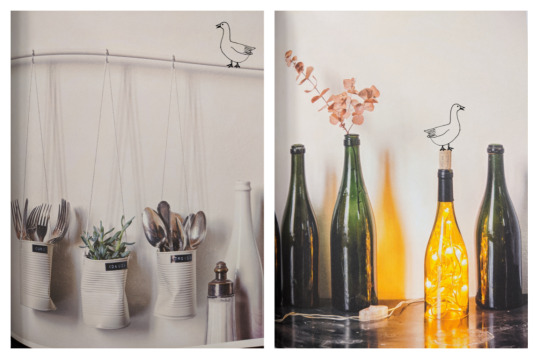
Upcycling is a great 'movement' and concept: rather than produce more STUFF, we can use what we already have. It's different from simply thrifting because you often change the material object's intended function, though not necessarily. Thrifted objects are found; upcycling requires work. DIY projects similarly require work, but don't necessitate that the materials are all found (e.g. "just buy some twine and you're all set!").
The social momentum building up DIY and upcycling is positive in America because Americans really ought to have stopped consuming and producing STUFF yesterday. Additionally, there’s a widening class gap, and more people are having to 'make do' with what they have. I don't make this distinction lightly: there are founts of these same design practices that are wealthy and artisanal, whereas others are, simply put: provoked by poverty. The former isn't "wrong" or "bad," and I don't think it's helpful to make these kinds of value judgments. However, this discussion brings us to my most critical reaction to this book: nobody has this sh*t at home!

The book Détournez les Objets du Quotidien couldn’t have been published with the everyday person in mind, even though the subtitle (in English) informs the potential reader that they would learn how to transform 'everyday' objects. Many of the projects, as aesthetically pleasing as they are, require absurd supplies, including: bell-shaped metal lamp hanger, strips of natural leather, plaster, “black hanging-lamp light cord with socket and light bulb,” carbon paper, wax pellets, number stamps for leather, bags of cotton filling, an S-hook, “dusty-rose matte wood paint,” “11 mother of pearl buttons 11/16 inch diameter,” 80 x 40 inch quilt batting, canvas luggage straps, and porcelain light bulb socket with mounting bracket. Additionally absurd are some of the required tools: electric screwdriver, crowbar, jigsaw, an auger bit, an awl, a double boiler, a label-maker, 1-inch diameter drill bit, 1 1/8 inch crochet hook, plaster, leather-craft roller, sewing machine, and staple gun.
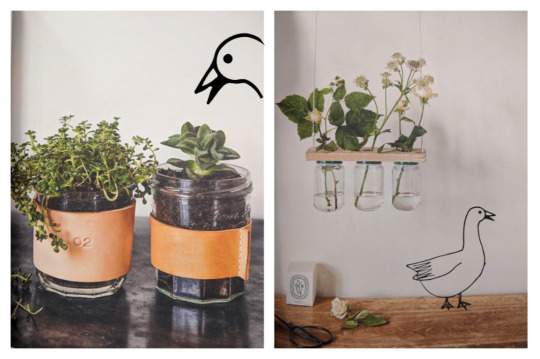
You might be saying to yourself: I have some of those, you're being too harsh, DesignMod. But I too have some of these objects. What you are noticing, though, is your privilege. (Don't be scared, just breathe.) You are in a position where you have things, things that arguably you would only need for the specific project at hand. That's all. But this is my problem with this book: the projects and designs require non-ordinary, non-everyday materials. The book in its mission is a) deceitful and b) not accessible to a large audience.

My frustration can be summed up looking at the preface:
"While recycling today is trendy, I want to take it even further...not by decorating our homes with second-hand objects, but by starting with everyday objects that we have at home or can find easily."
Great, sounds good!

"I propose that you 'upcycle' or repurpose these objects, so common and ordinary that we lose sight of their decorative potential: crates, wood pallets, white cotton sheets, glass jars, wine bottles, tin cans, white dishes, lampshades, and more."
Okay, I need to stop the author here. WOOD PALLETS?? I don't have bonus wood pallets laying around the house. I can understand empty wine bottles if someone in your household drinks. The first chapter starts off with wood pallets as the base material, suggesting that you go out asking grocery stores if you could take extras (definitively not at home). Other supplies come with recommended stores (e.g. white boxes from IKEA) which is also antithetical to using your own objects and inadvertently capitalist in it’s promotion of specific large retailers (as opposed to an individual artisans or ‘your local vendor’).

"Here are fifty ideas for easily transforming these objects into budget-friendly design creations that will add a 'rustic chic' flair to any home's decor. No need to be an expert in do-it-yourself crafts. All that's needed is the desire to implement the projects in the book."
This gets me to my final criticism: the book lacks creativity. Whereas the author or designer is creative (yet still adhering very much to trends), they do not encourage creativity whatsoever on the part of the reader. Materials are suggested with specific colors and dimensions. The back pages include any lettering printed out that you can tear and copy onto your project, exactly like what you see in the book. I don't see this as a positive: a) we all end up with the same stuff, b) the reader isn't learning anything in terms of lettering but also in terms of figuring out how they'd do a project, and c) the book subconsciously promotes consumerism by denying the reader the opportunity to determine their own project.
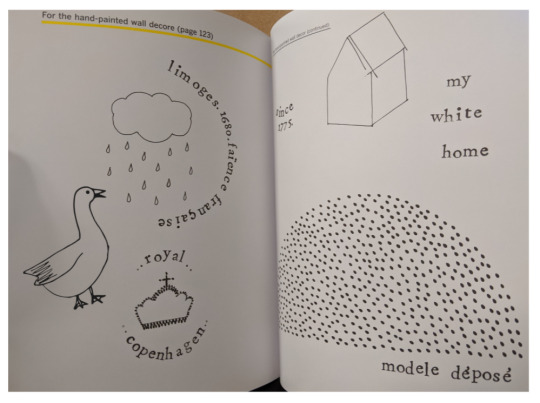


The book does offer a few guidelines for those attempting the projects, such as estimated duration, difficulty level, and technique applied. Ultimately, suggesting you add "since 1775" arbitrarily to a white plate implies a greater devotion to the superficial aesthetic of contemporary design, rather than actually considering where objects come from, how we engage with them, and our broader systems of production and consumption.
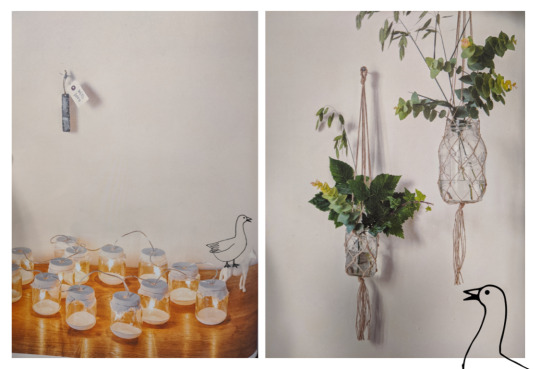
Overall, I did learn upcycling tips from this book, but in the end, I was profusely disappointed. If you really need very strict guidelines in your creative projects, as well as have the financial resources to gather all the required tools and materials, then you might like this book. I find it quite narrow, unoriginal, and inaccessible. I rate it 3/6 geese, because it is easy to read, the aesthetic is current, and there are lovely photos.

With loving curiosity,
DesignMod
#designmod#wht!#wht#wehavethoughts#wehavethoughts!#reviewblog#interior design#design#diy#upcycling#upcycle#thrifted#thrifting#vintage#reuse#aesthetic#scandinavian#cottage#country#distressed#white#plants#indoor
2 notes
·
View notes
Photo

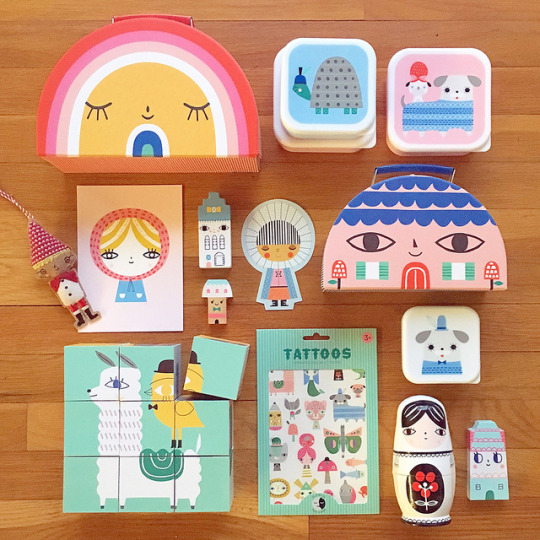
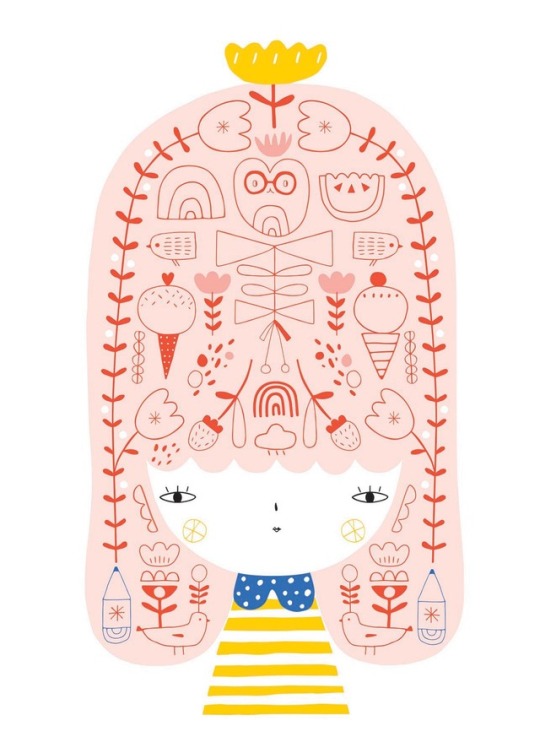
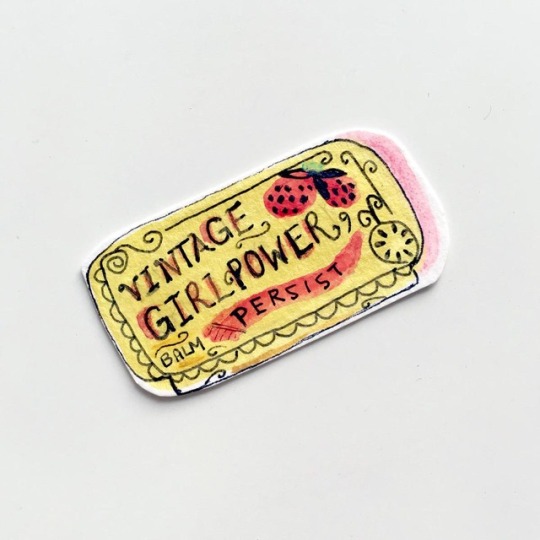



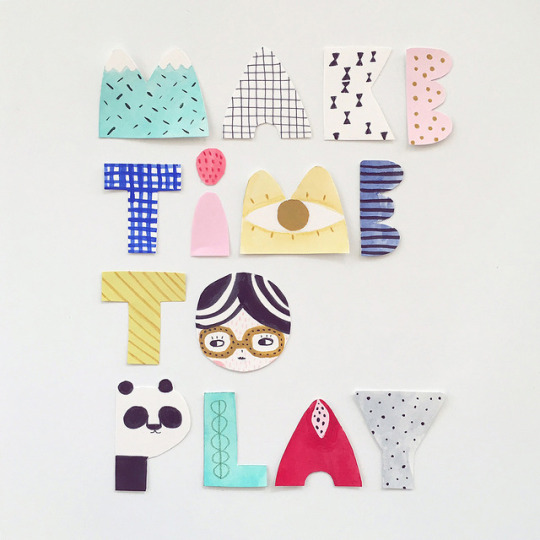
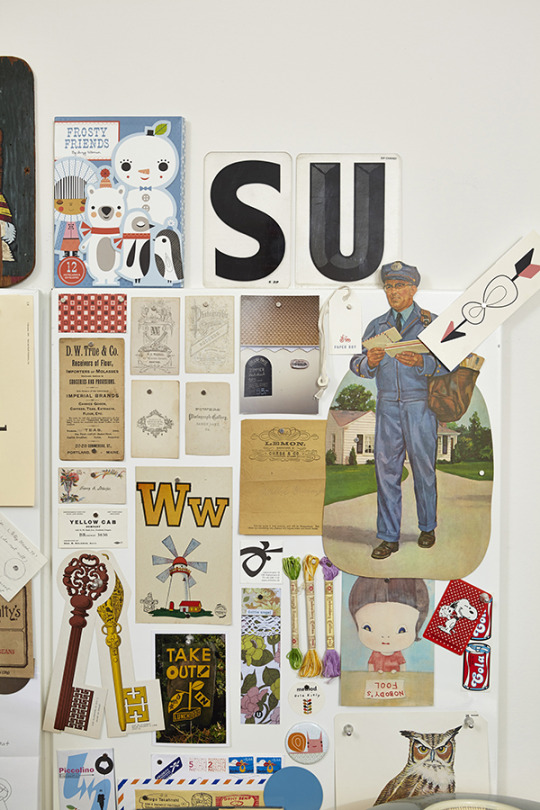

SKETCHY BEHAVIORS | Interview with SUZY ULTMAN
Growing up doodling, cutting out Peanuts comic strips, and sifting through the fabric from her mom’s sewing room, it is no wonder that artist, illustrator, and designer Suzy Ultman creates super fun, creative, and adorable drawings and patterns. We’re excited to find out more about Suzy and her work–from how one class changed her trajectory to some great tips on those looking to follow in her footsteps!
Photographs courtesy of the artist.
Who are you and what do you do?
Hi! My name is Suzy Ultman -- I'm an artist/illustrator/crafty girl, working, living, and playing in the Midwest. So far in my life, I’ve lived East Coast, West Coast, Midwest, and on 3 continents. My broad travels, love of nature, and soft spot for musicals have influenced my colorful, optimistic style.
How did you first get into drawing and doodling?
I’ve been doodling since I can remember. At about age 10, I started cutting out the Peanuts comic strips from the Sunday newspaper, and taping them into my scrapbook. Then, I’d spend hours upon hours drawing Snoopy. I also loved making doodles of food packages, making collages of magazine bits, creating my own bubbly typefaces, and writing & illustrating little stories & poems.
When did that lead you to creating your own illustrations and works ?
In high school, I discovered a talent for visual problem solving in a senior graphic design class. This led to undergrad and graduate work in graphic design, and a career in the field. Then, about 10 years ago, a close friend encouraged me to join a studio class taught by an agent, Lilla Rogers. I had just moved to Boston and was in temporary housing with 2 small kiddos. I found a sitter and committed to the course. At the end of the 8-week class, Lilla encouraged me to draw, draw, draw. I threw myself into creating my illustration portfolio. I’ve been drawing for a living ever since.
When you’re working on something new, either if it’s a pattern or a pin, what is that process like?
I approach every project the same: (1) Work as a team with the client (2) Find the story in the project (3) Have fun & play (4) Present a clear concept with a Suzy “wink”.
You create some really cute and fun patterns, what’s your interest or relationship with textiles? Have you always had an interest in making your own art into wear?
Growing-up, I loved spending time in my mom’s sewing room, looking through her piles of fabric, and hunting through her notions drawer for buttons. I’d collect bits of treasure, and make dolls & objects from whatever I could get my scrappy hands on.
With my fabric collections, I get to design textiles that will become a palette for making. It’s fun to imagine the endless possibilities that will be created from the fabric.
What’s one of your favorite creations you’ve made and why?
“Mr. Sun & Friends” wooden character set is one of my favorite creations. My client, PSikhouvanjou, urged me to follow my imagination. With that freedom, the characters came to life very organically — that’s always a pleasure! Also, I love telling a story through product design, and thinking about the ways the audience will relate to the object. By designing “Mr. Sun” to be attractive to children & whimsical adults, we created a toy for both play & display. It’s been wonderful to see how people have adopted these friends into their homes. For me, creating a product that brings joy, connects the family, and has a long shelf life in the home is a great feeling.
Do you keep a sketchbook or work your ideas as you go along? What type of things keep you inspired or are inspired by?
I have a sketchbook of drawings & doodles, and lots of little lists.
My studio wall is tacked full of inspiration which I’m constantly revisiting as I rotate through my collections. It’s an eclectic assortment of vintage, Dutch, Scandinavian, and Japanese ephemera, clippings, and fabric. I’m attracted to the clean beauty of Scandinavian design, and the rich storytelling of traditional folk art. I also love the textures and colors used in 1950s/60s cartoon background art.
My collections, along with spending time in nature, my family & friends, and traveling inspire my visual aesthetic.
What are your main art tools? Is there a medium you’re wanting to try but haven’t had the chance too yet?
I’m happiest with a fine pen, a wavy brush pen, markers, and watercolors. I’d love to get my hands on pottery in the near future!
Who are some artists that you’re inspired by and have influenced you throughout the years?
Mary Blair, Charles Shultz, Ed Emberley, Dick Bruna, Fiep Westendorp, Jim Henson, Seymour Chwast, Ben Shahn, Alexander Girard, Jonathan Adler, Yoshitomo Nara
Who are some artists you’d love to see us interview?
Carolyn Suzuki, Seonna Hong, Kelly Thorn
When you’re not working in the studio, what are you doing? What do you enjoy?
When the weather is nice, I have my coffee outside every morning, and watch the birds. On the weekends, you’ll find me whipping up a batch of hummus (extra garlic, please) or searching for the perfect brownie recipe. I enjoy building a fort with my boys, and taking them for a walk in the woods. I love the local book shops, vintage clothing stores, and antique malls. I meditate — often.
What do you think you’d be doing if you weren’t an artist? What career path would you have chosen?
I’d like to help people in vulnerable situations, possibly hospice care or an art therapist for children.
What would you tell someone who wants to follow in your footsteps?
Be yourself.
Make plans, but know that some of the best things that happen are completely unplanned.
Don’t take rejection personally. There are a lot of things behind the scenes that are out of your control. Just keep on keeping on.
Don’t be afraid to ask questions.
Create a community/support network.
What are your FAVORITE Vans?
Slip-ons for easy action.
Finally, can you tell us about any exciting things you’ve got coming up?
I can’t talk to you about any upcoming projects, but we are taking our annual family vacation to Canada very soon. I LOVE a roadtrip, so there will be plenty of snacks and books on CD. Yes, CDs — that’s how we roll!
FOLLOW SUZY | WEBSITE | INSTAGRAM
#Art#Vans#Vans Girls#Vans Art#Sketchy Behaviors#suzy ultman#interview#female artists#pattern#design#creativity#inspiration
42 notes
·
View notes